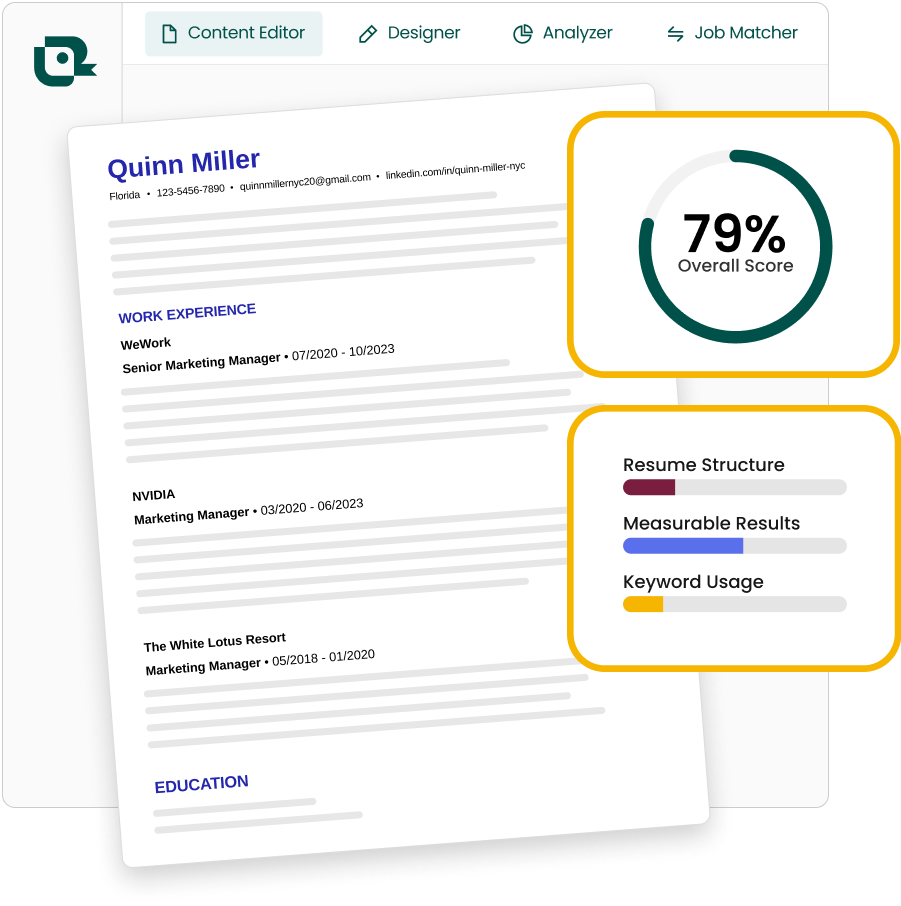3 key takeaways
- Learn what resumes and portfolios are and what each should include, so you can craft impressive application materials.
- Get a clear breakdown of the differences between your resume and portfolio—and how to ensure they complement each other
- Build a stronger application by knowing when to submit a resume, portfolio, or both (+ what to include in each)
When applying for a new role, you’ll need to submit a variety of job application materials, like a portfolio or resume. Each one offers a different way to capture and communicate your work experience. Which one you need to use (and when) isn’t always straightforward. Instead of thinking through your applications as portfolio vs resume, you should consider how the two complement each other. Sometimes, you’ll just need to submit one, while other times, you’ll submit the other…or both!
In this guide, we’ll break down what a resume is, what a portfolio is, and how they differ. You’ll discover when to use each, how to highlight your portfolio within your resume, why resume format matters, and tips for presenting your skills in the strongest possible light.
Resume vs portfolio: key differences
Though both resumes and portfolios are used in job searches, they differ in several ways. Here’s a side-by-side look at portfolios vs resumes:
When to use a portfolio vs a resume (and when you need both)
In almost all cases, you’ll submit a resume for every job role you apply for. A portfolio can help give you an edge. Below, we’ll get into jobs that absolutely require portfolios, situations where portfolios replace resumes entirely, and when to submit both your resume and your portfolio for the best results.
Some jobs, like creative industries, almost always require portfolios. If you’re in one of these fields, employers will expect to see samples of your work in addition to your resume:
- Designers
- Artists
- Writers
- Journalists
- Architects
- Marketers
- Photographers
- Models and actors
- Engineers
Can a portfolio replace a resume?
Generally, a portfolio does not replace a resume, except for freelancers or contractors where applicable. Even for freelancers, having a resume (or at the very least, a summary of your experience and accomplishments) handy is a wise idea. Be sure to follow instructions—if a job posting specifically asks for only a portfolio, submit that, but otherwise, you can generally default to include both.
Using portfolios and resumes together for maximum impact
It’s best to imagine that resumes and portfolios go hand-in-hand—the resume being the main entrée with the portfolio acting as the side to complete the meal. Your portfolio can also serve as a complementary document after you submit your resume—if you follow up with a recruiter or move on to the interview stage, your portfolio serves as further evidence of your skills and qualifications.
What is a resume and what is it used for?
Let’s start with the basics. Many jobs require a resume, so it’s become a standard part of the application materials most job searchers compile.
A resume is a detailed document that summarizes your work history, often in reverse chronological order. It’s typically one or two pages long, and can be created with Google Docs, Microsoft Word, or even a resume builder. specific resume building tools. You can create one resume that captures a general snapshot of your experience, or tailor what’s included on your resume to fit individual job applications.
Resumes help hiring managers get an overview of all the relevant skills you possess and decide whether to invite you for an interview. Creating and refining your resume is an integral part of the job search and job application process. You may send in a resume in a job application, or you may upload your resume to job search sites for recruiters to find you.
What to include in a resume
Resumes come in different formats with various sections, but there are universal items that should be included, like:
- Contact information
- Professional summary
- Work experiences
- Skills
- Education
- Certifications and awards, if applicable
- Relevant volunteer work
Here are more details to help you build out each section.
Contact Information: Basic, essential details about you: at a minimum, include your full name and email address. Depending on the type of role and industry you’re applying for, some resumes also include your phone number, location(city and state), and LinkedIn profile link.
Professional Summary: One-to-three sentence paragraph at the top of a resume highlighting your professional qualifications and career goals.
Work Experience: Each of your previous (relevant) roles, including the job title, company name, dates of employment, and a bulleted list of responsibilities and achievements under each role. This section will make up the majority of your resume’s content. If you’re early in your career, or are pivoting to a new field and lacking formal experience, consider adding a volunteer section to fill out your resume.
Relevant Skills: Soft skills and/or technical skills relevant to a specific job.
Education: Academic institutions you’ve attended, including graduation dates, degrees, and any relevant honors or awards. You should update this over time and remove details as they become less relevant — for example, including your high school graduation date while you’re in college, and then only including your college graduation information once you’ve graduated with your degree.
Resume best practices and tips
Your resume is your chance to make a first impression, so it needs to be polished, professional, and purposeful. A strong resume doesn’t just list your experience; it strategically presents your value.
As you build or refine your resume, keep these best practices in mind:
- Use a clean, functional design: Stick to a simple, professional format that emphasizes readability. Avoid excessive colors, graphics, or fonts that can distract from your content.
- Optimize for applicant tracking systems (ATS): Many companies use ATS software to filter resumes. To help yours get through, use a standard layout, and include keywords and phrases that match the job description.
- Organize for easy scanning: Whether it’s a recruiter or a digital system reviewing your resume, clear structure matters. Use consistent headers, bullet points, and sections to highlight the most relevant info quickly.
- Treat your resume as a living document: Update it regularly—not just when you’re job hunting. Add big wins, new certifications, or measurable outcomes as they happen so your accomplishments stay fresh.
- Tailor your resume for each job application: Customize your resume for the specific role by adjusting your summary, skills, and experience to align with the job description. Remove unrelated or outdated content as needed.
- Proofread carefully before submitting: Always double-check your resume for typos, grammar issues, or formatting glitches—especially after making edits. Small errors can leave a big impression.
💡Pro Tip: Updating your resume for each job you apply for is time-consuming, but worthwhile. Teal’s free AI Resume Builder helps you easily craft impactful summaries, bullet points, and more, tailored to each application you submit.
What is a portfolio and why is it important?
A professional portfolio serves as a creative, comprehensive compilation of work samples and projects you’ve worked on, providing visual evidence of your skills and accomplishments. It’s designed to showcase your skills and experience for recruiters, clients, and potential employers through actual examples. Often, you’ll submit a digital portfolio through an online link, PDF, or folder of work, but it can also be physical, depending on the industry and type of role you’re applying for.
Portfolios help employers get a visual overview of your talent and decide if you have what it takes to create something similar for them in the role. It’s a deliverable that complements the resume and the cover letter in the traditional sense; although, freelance creatives may use the portfolio as the only deliverable sent to potential clients.
What to include in a portfolio
Your portfolio should include a few components as evidence of your skills:
- The best examples of your work
- A brief bio or introduction
- Case studies or project stories
- Related achievements or awards
- Testimonials or references
- Contact information
- Resume link
Here’s more details to help you build out each section.
Examples of Your Best Work: The premise of a portfolio is to showcase your most impressive work, often visually. The type of examples can vary, from website designs and social media posts to plans, timelines, published works, and even makeup looks. This is the main content that should be in your portfolio, and can be presented in a variety of layouts.
Brief Bio or Introduction: A one-to-two sentence blurb outlining who you are, your main job title, and your area of expertise. If you have a work philosophy statement or tagline, include it here.
Case Studies or Project Stories: This is optional to include, but helps give context to the impact of your work.
Related Achievements and Awards: This section provides some metrics or awards tied to the projects you present in the portfolio. Think of it as the “proof” your projects were successful and worthwhile.
Testimonials or References: This portion should highlight a few kind words written by past employers or clients. While a resume may simply state “References available upon request” with the idea that the employers will do a background and reference check, a portfolio has the space to include them directly on the document. Freelancers will find this section particularly useful since clients don’t typically run background or reference checks, and may prefer to read through the testimonials instead.
Contact Information: Include essential information about how to reach you, such as your full name, phone number, email address, personal website link, and social media profile handles where relevant. You can also include links to book a call with you or to fill out a contact form.
Resume Link: Yes, you often should include your resume within or alongside the portfolio. This helps give a holistic picture of your work experience.
Different types of portfolios
Portfolios can vary, especially by the type of role you’re applying for or the industry you work in. A design portfolio for a graphic designer or architect needs to be very visual-based, while a writing portfolio needs ample space for links to published work. A portfolio can be housed on a personal website, a PDF document, or even online portfolio websites, like Behance, GitHub, Contra, LinkedIn, and more.
How to incorporate your portfolio into your resume
The key to a well-rounded application is to add a portfolio link in your resume or cover letter. That way, if a job application only hosts a slot to upload or input your resume, the hiring manager still has access to your full portfolio of work.
There are a few ways you can do this:
- Add your portfolio URL to the contact info section of your resume.
- If relevant, mention “Portfolio available at [URL]” in your resume summary or a dedicated section.
- Hyperlink text in the PDF of your resume (e.g., link your project names to portfolio pages).
- Include your portfolio link in your email signature when communicating with recruiters.
Since resumes are text-focused, including a portfolio link for visual roles is especially important.
Examples of resumes with portfolio links

David Brown, Backend Developer, links to his GitHub account where hiring managers can explore his projects, view stored code to judge his coding skills, and see real life samples.

Avery Adams, Content Manager, links to her Behance, a portfolio-hosting platform. There, hiring managers can view her projects, strategies, and writing samples.

Liam Chen, Project Manager, links to his website. There, the hiring manager can view his projects and services in more detail. Personal websites can serve as portfolios.
Add your portfolio to your LinkedIn profile, too
You can also add your portfolio directly to your LinkedIn profile for ease of sharing with recruiters, both on your resume and in applications.
Here’s how:
1. On your profile, go to your contact info section. Click the pencil icon to edit.

2. Under contact info, you’ll see Profile URL. Click this URL. You’ll be taken to public profile settings.

3. At the top right corner, you’ll see the section to edit your custom profile URL.

4. Type or edit the last part of your new custom public profile URL in the text box. We recommend your first and last name, or a variation of the sort.
5. Click Save.
Conclusion: Portfolio vs resume
When you’re applying for jobs, a resume is a must. A portfolio? That’s often what helps you stand out. While your resume summarizes your background, your portfolio brings it to life, showcasing real examples of your work and impact.
If you’re in a creative or project-driven field, don’t wait for an employer to request one. Make your portfolio a regular part of your application. Not sure where to start? Add a clear, clickable link right in your resume to make it easy for hiring managers to find.
You don’t have to choose one over the other. The most effective applications use both thoughtfully and strategically. Need help? With Teal, you can create tailored resumes, attach portfolio links, and keep everything in one place, so you’re always ready to apply with confidence.
Frequently Asked Questions
Can my portfolio be my resume?
No, your portfolio cannot be your resume when applying to a job. It’s traditionally appropriate to apply with a resume. Freelancers are the exception. If you’re trying to land a gig, contract, or client, a portfolio could also serve as a resume. When in doubt, use a traditional resume.
What is the difference between resume, CV, and portfolio?
A resume, CV, and portfolio are all tools you use to apply to and land a job. However, they have distinct differences. A well crafted resume highlights your professional background and professional capabilities, while a CV offers a more detailed approach, especially in academic and research roles. In contrast, portfolios provide visual evidence of your best work related to your skill set.
What is a resume portfolio?
A resume portfolio is a combination of the classic resume and a portfolio of work samples. Throughout multiple pages, it contains key resume sections such as professional summary, contact details, and work experience, and certifications. It will also include examples of your work—such as writing samples, coding projects, branding campaigns, projects, awards, and more. It's most used in creative professions.




.jpeg)


.jpg)


